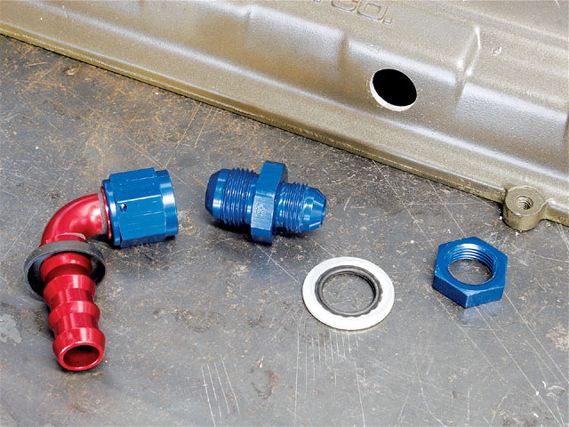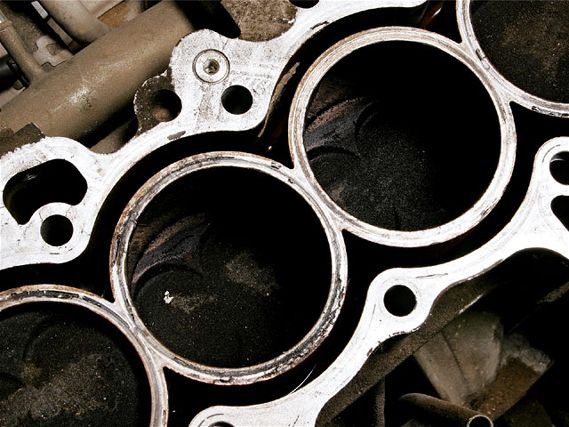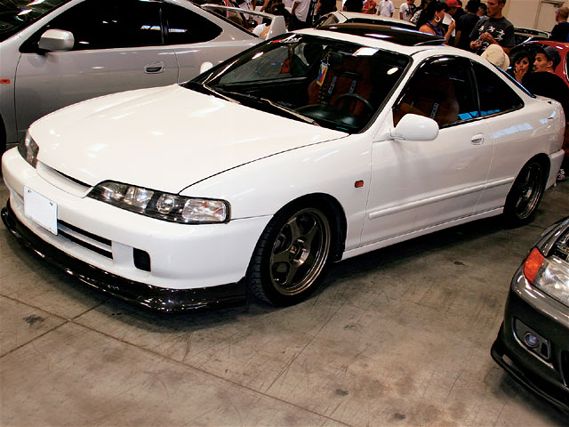 | Compression Ratios, Turbos, and Engine Swaps - Exhaust Notes October 2008
| Compression Ratios, Turbos, and Engine Swaps - Exhaust Notes October 2008
Hello Honda Tuning. I have a fully built, turbocharged D16Z6 in a '95 Civic EX coupe. It's not tuned yet, but the goal is 350 whp on pump gas. I have two specific questions that I'm hoping you can help me with. I realize this first question is a little late because the motor is already built, so maybe you could just ease my mind a little about my decision. I had Arias custom make me 77mm forged pistons and I slightly increased the stock 9.2:1 compression ratio to 9.5:1. I'm going for about 19 or 20 pounds of boost with my GT2871R with a TiAL T3 exhaust housing. My question is, finally, how dangerous/difficult do you think this slight increase in compression will make tuning, especially with such high horsepower goals? Secondly, I have an Allstar Performance catch can with a large filter, two openings for hoses near the top, and a drain plug at the bottom. I used large, 1/2-inch hoses-one hose goes to the stock hole in the valve cover, the other goes to the back of the block connected to the stock black box. All other stock PCV components have been removed. I've seen two or more hoses going to the valve cover for better breathing, however, I had a powdercoated valve cover previous to the turbo build and didn't want to drill through the coating to weld two AN fittings on. I'm worried that not having enough valve cover breathing is going to bite me in the ass. Am I going to be OK? Thanks so much.
Clark Pease
A compression ratio difference of .3:1 is very small, especially if you're still in the mid-to-low 9.0:1 range, so calm down. Even 9.5:1 is still a relatively low compression ratio and, provided your tuner knows what he's doing and you've got good gas, your engine will be fine. Your breather tank setup sounds fine too but you should check a couple of things. Look at the fitting you used to connect your 1/2-inch hose to your valve cover. What is its internal diameter? Remember that the smallest part of the system will dictate how well it works. A 1/2-inch line with a 1/4-inch inlet won't do much good. The same thing goes for your connection at the rear. The fittings exiting the OEM breather box are relatively small. There are alternative ways to adapt AN fittings to your valve cover that don't involve welding. Check out the August issue of Honda Tuning where we use Earl's AN unions, bulkhead nuts, and Stat-O-Seals for a B-series breather tank setup that doesn't require any welding-just a good drill bit and some careful measuring. Also, keep in mind that the valve cover isn't the only place you can tap into for crankcase breathing, although it's often the easiest. Remember that, hence the name, crankcase pressure originates from the engine block.
Please help me with this. I've been searching numerous Honda forums for this answer. In the forums, people say that the B20B/Z sleeves are not the same as the sleeves in other B-series engines; in fact, they say they're more brittle. I have a hard time getting a grasp on this because to me it would seem easier to build the B20 on the same line as the other B-series engines (same materials, castings, etc.) with obvious differences like displacement and so forth. In short, can you please inform me if in fact the B20B/Z has different sleeves than the other B-series engines, and if they're weaker than its siblings? Thank you in advance.
Stumped in Florida, Tony Fabulous
The forum guys are partially right. The B20B/Z sleeves are different from other B-series ones but they aren't necessarily any more brittle. In fact, the materials are the same (cast iron), the B20B/Z sleeves are just thinner to account for the larger bore size without sacrificing too much space within the block's water jackets. As you might expect, thinner sleeves are weaker sleeves so B20B/Z buildups must be considered more carefully. Although brittle just isn't the right word.
 | Compression Ratios, Turbos, and Engine Swaps - Exhaust Notes October 2008
| Compression Ratios, Turbos, and Engine Swaps - Exhaust Notes October 2008
Hey, I recently bought an '89 Prelude with the B20A5 engine and I want to swap it for something with more kick, but I also don't want to have to swap the tranny. I was wondering if you could help me out since I'm new to Honda. Is there anything that would bolt right in? I appreciate the help.
Will Greenlow / Buford, Ga.
There are H22A bolt-in kits out there, but you're going to have to use an H- or F-series gearbox if you go that route. The H22A's and B20A5's bell housings are completely different from one another. In order to use your existing transmission with the H engine you'd need to fabricate a block-to-transmission adapter plate, which would also require a custom flywheel. It's also unlikely that the original transmission mount would line up with the chassis once it's bolted up to the H block. Do yourself a favor, if you plan on doing an H22A swap, do the whole swap. It's much easier that way. Now all you've got to worry about is the wiring.
I have a road trip planned with an '08 Civic Si coupe. With the factory engine and transmission setup, what rpm will give me the best mileage over a constant distance (freeway): 2,900 or 3,100 rpm? None of the techs at the dealers can answer that for me. Does anyone know this answer?
Orien / Ellicott City, Md.
There are two ways for you to get your answer, although I don't think a difference of 200 rpm is going to be significant enough for you to notice. You can either access the ECU's fuel tables to find out injector and load characteristics at those two rpm values, which is rather unlikely unless you've got some fairly sophisticated equipment in your garage, or you can hook up a wide-band air/fuel meter and log the different values. This might not be a bad idea. Keep in mind that mileage will almost constantly vary depending on the load placed on the vehicle, unless you plan on spending your entire road trip on a surface that's at a constant grade and with a constant wind resistance. You have to consider slight downhill or uphill grades that you might not even notice-situations like these can make arbitrary numbers like your 2,900 or 3,100 rpm pretty much pointless. The only real way to get the real-time data that you need is with an air/fuel meter. Even Honda knows this, that's why many of the new Accords, TSXs, and other Acuras display real-time mpg info right from the dash. But then again, is it worth it for you to spend $500 on a wide-band air/fuel meter so that you can save $8 in fuel on your road trip?
I have a '95 Honda Accord with the slow F22B non-VTEC engine in it. I was planning on doing an H22A swap for the F22B but then I was reading about how H-series motors can't hold boost well and in time I wanted to boost my Accord. I also heard that the F-series motors can hold boost easily. So, I was wondering, is the H22A a better swap or should I keep my F22B and just boost that engine?
Brant / Spencer, N. C.
 | Compression Ratios, Turbos, and Engine Swaps - Exhaust Notes October 2008
| Compression Ratios, Turbos, and Engine Swaps - Exhaust Notes October 2008
OK, so you're curious about the classic H versus F dilemma. First off, there are very few differences between the F22B and H22A bottom ends. They have similar block castings and a bore difference of only 2mm, which means cylinder spacing is similar. Their strokes differ by less than 5mm and their rods and cranks are manufactured using similar methods so, in terms of strength and reliability, or as you put it, how much boost it will "hold," you won't see much of a difference between the two. We suggest sticking with the SOHC F-series engine though, just not the SOHC F-series that you have. You might consult with legendary F-series tuner Bisi Ezerioha (www.bisimoto.com) if you're interested in learning more. The Bisimoto crew swears by the single-cam F-series engines, but not all of them-their weapons of choice are the F-series powerplants found in the '90-'93 Accord chassis. Although your F22B1's intake ports are quite efficient, your exhaust ports are not. Cylinder's two and three are paired tightly together, while cylinders one and four are spaced toward the outer ends of the cylinder head. The design makes for difficult exhaust flow, which will hurt you no matter what your performance goals are. Find yourself an early non-VTEC F-series, which is arguably much cheaper than an H22A, and forget about those twin-cam fantasies. Of course, if you really want to save a few bucks, just get yourself an older F top end and bolt it to your existing short block. The conversion is simple and, once it's all done, all you'll really have to do is worry about finding a transmission that will keep up.
Hello sir. I plan on getting an '09 Civic Si at the end of this year. I have a '98 Acura Integra LS, and it's automatic. I was thinking about converting it to manual, throwing a GSR in it, and making it a project car, but people have been telling me that it's not worth the money and time and that I might as well just buy a GSR. I really dig the leather interior but the tranny's blown and it doesn't run. So what do you think is the best thing to do?
Gilbert Martinez / Mesa, Ariz.
It all depends on how attached you are to your LS. If the interior and body are clean, stick with what you've got and swap in the drivetrain that you want. You already know your car's history in terms of what's wrong with it and what's not wrong with it-you can't say that about some random GSR you finger point to in the classifieds. However, if your LS is not in acceptable condition, meaning it needs bodywork, has been crashed, or any other undesirable scenario you can think of, you're probably better off unloading it for a mint GSR, just be prepared to pay the difference. If you do decide to keep your LS, the auto-to-manual conversion is relatively easy, however, it'll cost you several hundred dollars more than a typical engine swap simply because you'll need all sorts of five-speed components to make it all work. Items like these typically won't be included when you price out that B18C.
Got Questions, Comments, Love, Or Hate?
Send Your Letters To:
Editorial@Hondatuningmagazine.Com
Or Snail Mail To:
2400 E. Katella Avenue, Suite 1100
Anaheim, CA 92806
